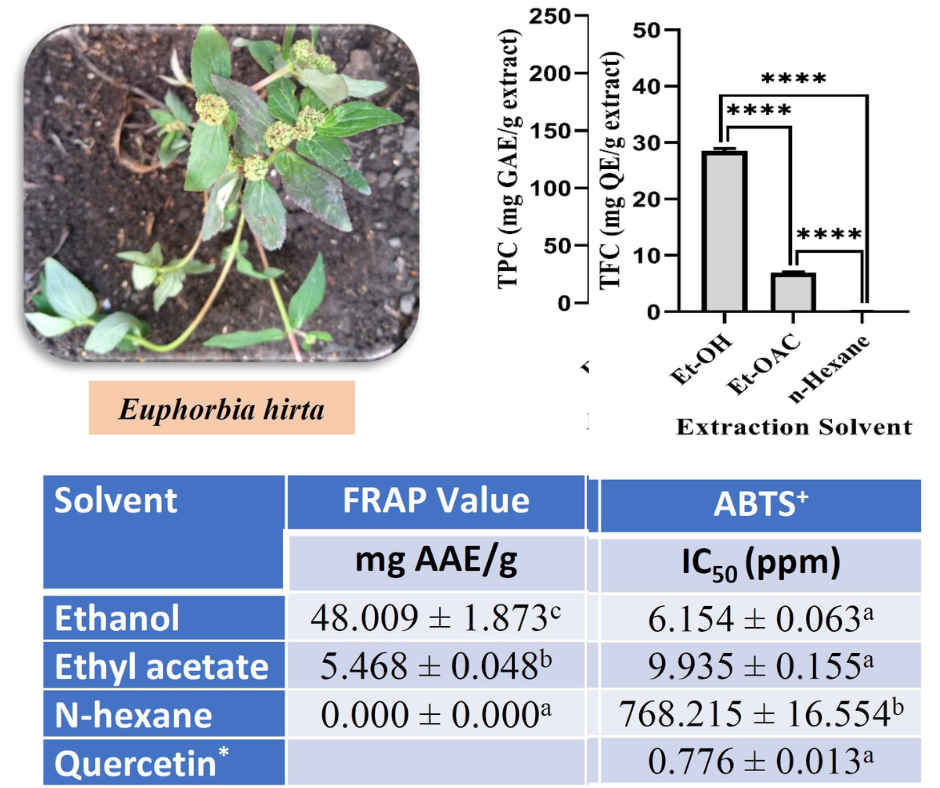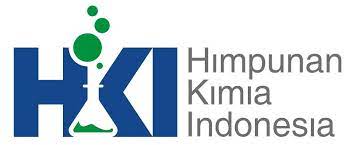
Effect of different solvents on antioxidant activity of Euphorbia hirta L. extract
Authors
Nyoman Suarjana , Made Nyandra , Ni Putu Widya Astuti , Ni Made Kurniati , Ni Luh Utari Sumadewi , I Made Wisnu Adhi Putra , Nurrahman AndriantoDOI:
10.29303/aca.v8i2.256Published:
2025-11-28Issue:
Vol. 8 No. 2 (2025)Keywords:
Antioxidant, Euphorbia hirta, Flavonoids, Phenolics, SolventArticles
Downloads
How to Cite
Downloads
Metrics
Abstract
Euphorbia hirta L. is a species of plant renowned for its antioxidant properties. However, the optimal solvent for extracting these bioactive compounds to maximize antioxidant activity had not been systematically identified and compared. Previous knowledge suggested that solvent choice affects yield and efficacy; however, there was a lack of conclusive, comparative data specifically for E. hirta extracts using different solvents. The focus of this work was to investigate how different solvents affected the content of phenolics and flavonoids, as well as the antioxidant effect of E. hirta extract. The aerial part of E. hirta powder was extracted with ethanol, ethyl acetate, and n-hexane to obtain the crude extracts. Folin-Ciocalteu reagent and AlCl3 solution were used to assess the total phenolic and flavonoid contents, respectively. The ferric reducing antioxidant power (FRAP), 2,2-diphenyl-1-picrylhydrazyl (DPPH), and 2,2-azino-bis (3-ethylbenzothiazoline-6-sulfonic acid) (ABTS) techniques were used to assess antioxidant activity. The total content of phenolics and flavonoids of E. hirta ethanol extract (127.827 ± 2.609 mg GAE/g extract and 28.507 ± 0.464 mg QE/g extract, respectively) was substantially higher than that of the other extracts (p<0.0001). The findings of the FRAP test exhibited that the E. hirta ethanol extract (48.009 ± 1.873 mg AAE/g extract) had a substantially greater reducing power value (p<0.0001) in comparison to other extracts. The ethanol extract of E. hirta had a considerably lower IC50 value (6.154 ± 0.063 ppm and 9.429 ± 0.183 ppm for DPPH and ABTS assays, respectively, with p<0.0001) than the other extracts. This study found that solvent polarity had a substantial influence on the antioxidant activity of E. hirta extracts, with ethanol being an optimal solvent for the extraction procedure.
References
Pizzino G, Irrera N, Cucinotta M, et al. Oxidative stress: Harms and benefits for human health. Oxid Med Cell Longev 2017; 2017: 1–13.
Jomova K, Raptova R, Alomar SY, et al. Reactive oxygen species, toxicity, oxidative stress, and antioxidants: chronic diseases and aging. Arch Toxicol 2023; 97: 2499–2574.
Sahertia YS, Putri SH, Chaerunnisaa AY. Aktivitas antioksidan dan penentuan nilai SPF ekstrak etanol tanaman patikan kebo (Euphorbia hirta L.) dalam sediaan krim tabir surya. Maj Farmasetika 2023; 8: 503–516.
Basyal D, Neupane A, Pandey DP, et al. Phytochemical screening and in vitro antioxidant and anti-inflammatory activities of aerial parts of Euphorbia hirta L. Journal of Nepal Chemical Society 2021; 42: 115–124.
Sharma N, Samarakoon KW, Gyawali R, et al. Evaluation of the antioxidant, anti-inflammatory, and anticancer activities of Euphorbia hirta ethanolic extract. Molecules 2014; 19: 14567–14581.
Tran N, Nguyen M, Le KP, et al. Screening of antibacterial activity, antioxidant activity, and anticancer activity of Euphorbia hirta Linn. extracts. Applied Sciences 2020; 10: 8408.
Gupta SS, Azmi L, Mohapatra PK, et al. Flavonoids from whole plant of Euphorbia hirta and their evaluation against experimentally induced gastroesophageal reflux disease in rats. Pharmacogn Mag 2017; 13: S127–S134.
Meda RN-T, Kam SE, Kagambega W, et al. A review on bioactive compounds isolated from Euphorbia hirta L. American Journal of Plant Sciences 2023; 14: 710–726.
Sudha TS, Padmini R. Evaluation of bioactive compounds in Euphorbia hirta Linn. leaves extract using gas chromatographic and mass spectroscopic techniques. Journal of Pharmaceutical Negative Results 2023; 14: 1988–1995.
Subandrate, Sinulingga S, Adma AC, et al. Effect of solvent polarity on secondary metabolite content and α-glucosidase enzyme IC50 of Dendrophthoe pentandra (L). Miq leaves extract. Jurnal Ilmu Kefarmasian Indonesia 2024; 22: 1–7.
Afrellia RE, Puspitasari AD. Analysis of total phenolic and flavonoid levels in carrot (Daucus carota L.) extract with different solvents polarity. Sainteknol 2023; 21: 43–51.
Putra IMWA, Kusumawati IGAW, Sumadewi NLU. Physical characteristics, total phenolic, and flavonoid content of Coccinia grandis (L.) Voigt leaves extract. Acta Chimica Asiana 2021; 4: 114–119.
Sekhon-Loodu S, Rupasinghe HPV. Evaluation of antioxidant, antidiabetic and antiobesity potential of selected traditional medicinal plants. Front Nutr 2019; 6: 1–11.
Putra IMWA, Ate OT, Kusumawati IGAW, et al. Water extracts from the combination of Coccinia grandis (L.) Voigt leaves and Averrhoa bilimbi L. fruits with antidiabetic properties: An in vitro study. Asian J Pharm Clin Res 2020; 13: 24–28.
Lee KJ, Oh YC, Cho WK, et al. Antioxidant and anti-inflammatory activity determination of one hundred kinds of pure chemical compounds using offline and online screening HPLC assay. Evid Based Complement Alternat Med 2015; 2015: 1–13.
Pawarti N, Iqbal M, Ramdini DA, et al. Pengaruh metode ekstraksi terhadap persen rendemen dan kadar fenolik ekstrak tanaman yang berpotensi sebagai antioksidan. Medical Profession Journal of Lampung 2023; 13: 590–593.
Ghaffar N, Perveen A. Solvent polarity effects on extraction yield, phenolic content, and antioxidant properties of Malvaceae family seeds: a comparative study. New Zealand Journal of Botany 2024; 0: 1–11.
Durazzo A, Lucarini M, Souto EB, et al. Polyphenols: A concise overview on the chemistry, occurrence, and human health. Phytother Res 2019; 33: 2221–2243.
Teshika JD, Zakariyyah AM, Zaynab T, et al. Traditional and modern uses of onion bulb (Allium cepa L.): a systematic review. Crit Rev Food Sci Nutr 2019; 59: S39–S70.
Zhang H, Tsao R. Dietary polyphenols, oxidative stress and antioxidant and anti-inflammatory effects. Current Opinion in Food Science 2016; 8: 33–42.
Zeinali M, Rezaee SA, Hosseinzadeh H. An overview on immunoregulatory and anti-inflammatory properties of chrysin and flavonoids substances. Biomed Pharmacother 2017; 92: 998–1009.
Bibi N, Shah MH, Khan N, et al. Variations in total phenolic, total flavonoid contents, and free radicals’ scavenging potential of onion varieties planted under diverse environmental conditions. Plants 2022; 11: 950.
Munteanu IG, Apetrei C. Analytical Methods Used in Determining Antioxidant Activity: A Review. International Journal of Molecular Sciences 2021; 22: 3380.
Gulcin İ, Alwasel SH. DPPH radical scavenging assay. Processes 2023; 11: 2248.
Mishra SB, Verma A, Vijayakumar M. Preclinical valuation of anti-hyperglycemic and antioxidant action of Nirmali (Strychnos potatorum) seeds in streptozotocin-nicotinamide-induced diabetic Wistar rats: A histopathological investigation. Biomarkers and Genomic Medicine 2013; 5: 157–163.
Bitwell C, Indra SS, Luke C, et al. A review of modern and conventional extraction techniques and their applications for extracting phytochemicals from plants. Scientific African 2023; 19: e01585.
Hou Y, Wang Y, Tan X, et al. Investigating the antioxidant efficiency of tea flavonoid derivatives: A density functional theory study. Int J Mol Sci 2025; 26: 2587.
Azahar SS, Raja PB, Mohamad Ibrahim MN, et al. Extraction of flavonoids from Butterfly blue pea (Clitoria ternatea) flower as carbon steel corrosion inhibitor in CO2 environment: Experimental and theoretical approaches. Journal of Molecular Liquids 2024; 396: 124056.
Ohunayo AS, Elekofehinti OO, Oladunmoye MK, et al. Effect of different solvents on phytochemicals of Rinorea oblongifolia leaves and stems. Asian J Biol Sci 2025; 18: 811–816.
Barchan A, Bakkali M, Arakrak A, et al. The effects of solvents polarity on the phenolic contents and antioxidant activity of three Mentha species extracts. Int J Curr Microbiol App Sci 2014; 3: 399–412.
Nouioura G, El fadili M, El Barnossi A, et al. Comprehensive analysis of different solvent extracts of Ferula communis L. fruit reveals phenolic compounds and their biological properties via in vitro and in silico assays. Sci Rep 2024; 14: 8325.
Fadhlillah FM, Miranti M, Wibowo DP, et al. Determination of phenolic and flavonoid total levels and antioxidant activity of ethanol, ethyl acetate, and n-hexane extracts of Citrus reticulata Blanco fruit peel by DPPH and ABTS methods. JFG 2024; 10: 191–213.
Sukairi WAW, Rose LC, Asari A, et al. Correlation between TPC and TFC with antioxidant activity of Piper sarmentosum extract and its formulation for cosmetic purposes. Universiti Malaysia Terengganu Journal of Undergraduate Research 2021; 3: 51–60.
Muflihah YM, Gollavelli G, Ling Y-C. Correlation study of antioxidant activity with phenolic and flavonoid compounds in 12 Indonesian indigenous herbs. Antioxidants (Basel) 2021; 10: 1530.
License
Copyright (c) 2025 Nyoman Suarjana, Made Nyandra, Ni Putu Widya Astuti, Ni Made Kurniati, Ni Luh Utari Sumadewi, I Made Wisnu Adhi Putra, Nurrahman Andrianto

This work is licensed under a Creative Commons Attribution-NonCommercial-ShareAlike 4.0 International License.
Authors who publish with ACA: Acta Chimica Asiana agree to the following terms:
- Authors retain copyright and grant the journal right of first publication with the work simultaneously licensed under a Creative Commons Attribution-NonCommercial-ShareAlike 4.0 International License. This license allows authors to use all articles, data sets, graphics, and appendices in data mining applications, search engines, web sites, blogs, and other platforms by providing an appropriate reference. The journal allows the author(s) to hold the copyright without restrictions and will retain publishing rights without restrictions.
- Authors are able to enter into separate, additional contractual arrangements for the non-exclusive distribution of the journal's published version of the work (e.g., post it to an institutional repository or publish it in a book), with an acknowledgement of its initial publication in ACA: Acta Chimica Asiana.
- Authors are permitted and encouraged to post their work online (e.g., in institutional repositories or on their website) prior to and during the submission process, as it can lead to productive exchanges, as well as earlier and greater citation of published work (See The Effect of Open Access).





 Indonesian Chemical Society, Chapter Nusa Tenggara. Jalan Majapahit 62 Mataram, University of Mataram, 83125, Indonesia
Indonesian Chemical Society, Chapter Nusa Tenggara. Jalan Majapahit 62 Mataram, University of Mataram, 83125, Indonesia





